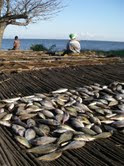Historically, the conventional theory used to explain the impoverished conditions in the small scale fishery focuses on two points: 1) the Malthusian limitations of the resource and 2) the open access nature of fisheries, leading to the tragedy of the commons.
Thus, poverty is said to be so widespread because fishery resources are susceptible to rampant over-exploitation and it is hardly a closed access system. In addition, fishing has been understood as a last resort for many in rural areas, particularly in the developing world. Seems like a plausible explanation, but this is only a part of the story.
First, as Christopher Béné and others have pointed out this argument can lead to a path of circular reasoning . Here it is: people fish because they are poor, and fishers are poor because they fish. Along this line, we are stuck indefinitely.
But, as suggested in the title of this entry- Fishery and poverty do not rhyme (in any literal or metaphorical sense)! The question is how do we come to understand and explain poverty?
The emerging thought speaks to larger social, economic and political factors.
To begin, political influence ensures unfair access to fishing rights by favouring the wealth and politically advantaged and dismissing the small scale, artisanal fishers.
For instance, in some regions, fishing rights are treated as a commodity by being sold to wealthy fishers and large company owners. Many small-scale fishers are desperate for the money, despite the fact that the amount paid to them is only a fraction of what could be obtained through actually fishing. The power imbalance that exists between ship and factory owners and the fishers leaves the latter is a highly vulnerable position.

http://www.blogtheberkshires.com/haiti/2006/10/tete_fret_1.html
In short, those in power (i.e. those with create and influence policy) maintain the current status quo, by upholding those policies that do not accurately consider the rural, small-scale fishery context. This includes a lack of support for the adaptations and strategies that fishers and communities use to engage in the fishery.
To enrich our understanding of fishers, and the poverty they experience in small-scale fishing operations, one approach that has been offered is the livelihoods framework ., which aims to address place-based solutions to the issue of poverty. Through this, we may get better sense of the many factors that contribute to poverty in the fishery.
What do you think?
Post by Janelle, Jen, Lynn and Jessica




